Hamster Supplies List: 14 Must-Haves for Your Hamster

Adopting a new pet hamster can seem overwhelming, with so many things to prepare and research before bringing them home.
I hope to make this process easier for you by providing a complete list of everything your hamster needs to be happy and healthy.
While pet stores often sell cheap “hamster starter kits” that supposedly include everything you need, those hamster homes are not even remotely large enough to meet the needs of these active animals. Starter cages are the equivalent of us living in a small room our entire life. Hamsters need and deserve much more than that.
Keep reading to find out which supplies your hamster needs to thrive!
Hamster Supplies Checklist
Before welcoming your furry friend, make sure to have these essential supplies on hand:
- A Spacious Cage
- Suitable and Safe Bedding (Substrate)
- Nesting Material
- A Sand Bath
- A Large Wheel
- Hidey Houses
- A Food Bowl
- A Water Bottle or Bowl
- Healthy Food
- Chew Toys
- Cage Accessories and Enrichment
- A Playpen
- A Carrier or a Small Travel Cage
- Exotic Vet & Emergency Savings
Continue reading to learn more about each of these necessary items.
A Spacious Cage
When shopping for a hamster cage at a pet store, it’s important to keep in mind that not all cages meet the minimum size requirements. To ensure that your hamster has a comfortable home, it’s important to do some research ahead of time and confirm the cage dimensions before making a purchase. By taking a little extra time to make an informed decision, you can ensure that your hamster has a cozy and suitable home.
Hamsters are naturally active animals with high levels of energy. In the wild, they roam and explore over long distances, traveling up to 6 miles each night in search of food and adventure. A spacious and stimulating environment that allows them to stretch their legs and explore their surroundings will ensure your pet is happy and occupied.
Here are some things to consider when getting a hamster cage:
- Ideally, it should have a minimum of 775 square inches (5000 cm²) to provide enough space and enrichment to occupy your pet.
- It should have a deep base to hold enough bedding for burrowing.
- It needs to provide enough ventilation so it shouldn’t be completely closed off. If you use a large aquarium, you should buy or make a mesh top to allow airflow.
We have a list of suitable hamster cages if you’re unsure what kind of cage you need.
Suitable and Safe Bedding (Substrate)
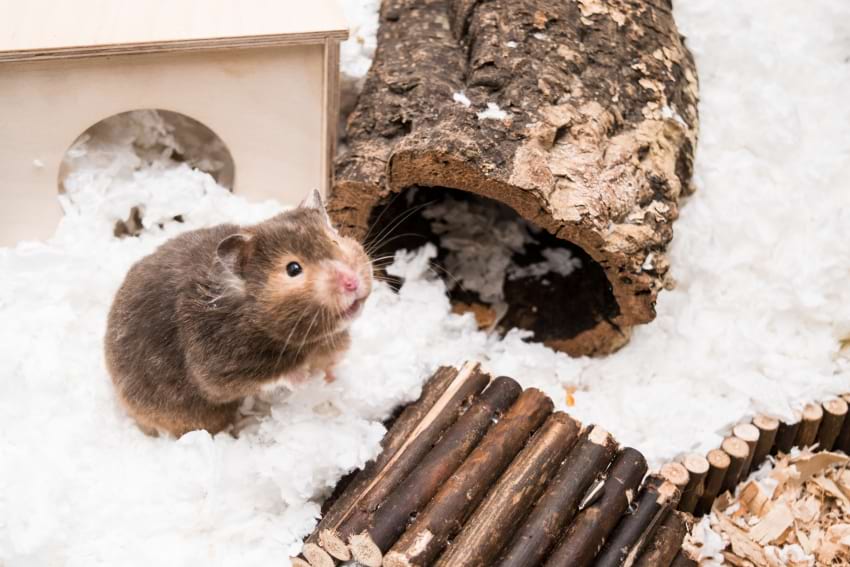
Bedding, or substrate, is the material that will fill the bottom of the cage so your hamster can burrow in it.
A deep substrate is an essential part of your hamster’s new home. Hamsters are naturally burrowing animals that spend most of the day sleeping and hiding in their underground chambers. As prey animals, they feel exposed and vulnerable without an option to hide in their burrow. Providing deep bedding will let your pet express their natural behaviors and feel protected, which is essential for their well-being.
How deep should the substrate be exactly? That depends on the hamster species as they differ in size:
- Dwarf (Campbell’s, Winter White, Roborovski) and Chinese hamsters: 10 inches of bedding or more would be ideal, the minimum being 6 inches.
- Syrian hamsters: ideally, 12 inches of bedding, but the minimum is 10 inches.
Bedding depth is not the only important thing – we also have to ensure the bedding we use is safe and can hold burrows without collapsing.
Some of the best options for a hamster substrate are:
Not all kinds of aspen bedding are good at holding burrows, so you might need to reinforce it with paper bedding. For example, you can do three parts aspen and one part paper bedding. It’s also a good idea to mix hay in between layers of bedding as it helps keep the burrows stable and firm.
In Europe, aspen shavings are not that easy to find, so spruce shavings are the go-to choice, along with paper bedding. Even though spruce is softwood (and softwood contains phenol which can cause respiratory issues in small pets), spruce is known to have exceptionally low phenol levels – almost as low as hardwoods such as aspen. You can read about it in more detail here.
Some bedding options are unsafe and should be avoided:
- Cedar and pine shavings contain phenols that can cause respiratory issues
- A product called “hamster wool”
- Clay-based cat litter
- Sawdust
Nesting Material
While the substrate is there to allow your pet to burrow, absorb the pee, and remove odor, nesting material will be used by your hamster to build their nest.
Hamsters love to create their nest by themselves, so all you need to do is provide suitable materials they can use in any way they want.
Some of the nesting materials hamsters love to use are:
- Soft hay, such as Orchard and Botanical
- Toilet paper sheets
- Paper napkins
- Paper towels
- 100% natural moss (no dye)
A Sand Bath
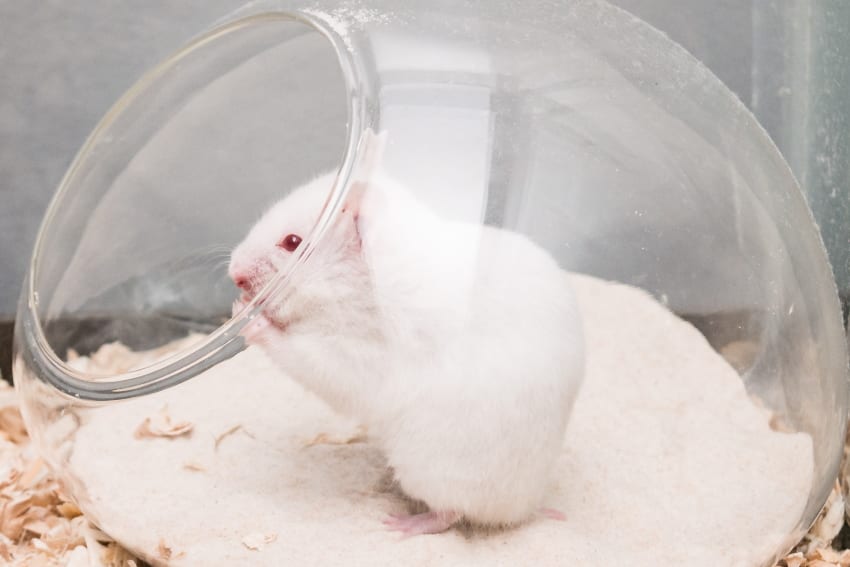
Hamsters have fluffy coats that can easily become dirty and matted. A sand bath will help remove dead skin, promote fur growth, and keep their coats clean and shiny. If you find that your hamster is using a sand bath as a toilet, you can add another one that your hamster can use as a bath while the first one will be his toilet.
There are several safe options to use for your pet’s sand bath:
- Chinchilla bathing sand
- Reptile sand – natural color sand with no added minerals or calcium (a good example is Reptisand)
- Children’s play sand – it should be heat treated. If it’s not, you’ll have to sanitize it by baking it in the oven for 20 min at 350°F (180°C). It’s also recommended to sift it through a sifter to remove the larger chunks that could hurt your hamster’s skin.
Unsafe types of sand:
- If it’s labeled as “dust” or “powder,” it is too fine and can cause respiratory infection
- Scented sand
- Colored sand
- Sand with added minerals or calcium
You can use any shallow container for the sand, as long as it’s big enough so your pet can roll around in it.
A Large Wheel
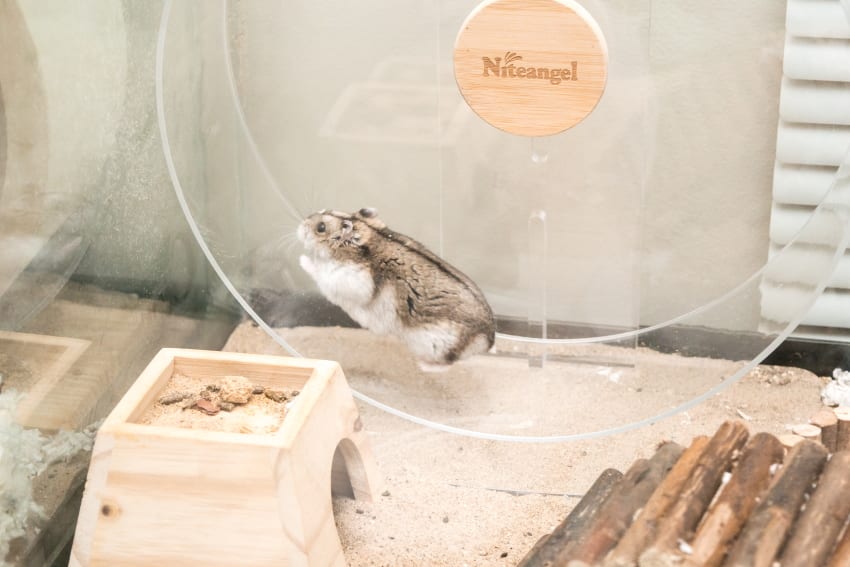
Most wheels built into a hamster cage are much smaller than the required minimum. Small wheels don’t allow your hamster to stretch out properly while running. Their backs are bent, which can result in back injury or pain.
A wheel should have a large enough diameter so a hamster can run with their backs straight. If your pet’s back is curved while running, it means the wheel is too small.
To make sure the wheel is large enough, follow these minimum size requirements:
- 8″ in diameter (20 cm) for dwarf species
- 10″ in diameter (25 cm) for Chinese hamsters
- 11’’ in diameter (28 cm) for Syrian hamsters
The wheel needs to be made of solid material – no metal bars or mesh, which can trap your pet’s feet and toes or cause a foot infection called bumblefoot. Always opt for an upright wheel and not a flying saucer.
Note: Hamster balls should also not be used as they are dangerous for multiple reasons.
Hidey Houses
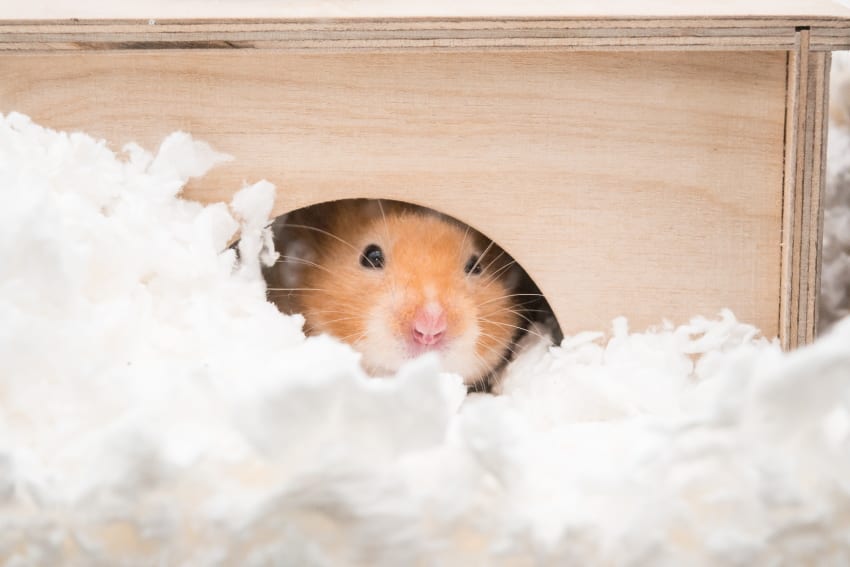
In the wild, hamsters live in complex burrows with several chambers. They have separate chambers for toileting, sleeping, and storing food. A multi-chamber hidey house is the best option for your hamster as it allows them to use different rooms for different purposes, just like they would in the wild.
If your pet has a hidey house with only one room, this can promote unhygienic habits and cause your pet to urinate where they sleep and store food.
A hamster house should also be big enough to allow your pet to separate their toilet, kitchen, and sleeping areas. Aim for a house no smaller than 30cm x 20cm (12in x 8in). If you have a Syrian hamster, they will benefit from a house even larger than that.
A bottomless house can be easily scooped up to clean the hamster’s toilet or remove old food. Place it on the deep bedding to allow your hamster to burrow underneath and expand the chambers.
A Water Bottle or Bowl
While you can use either a water bottle or a bowl, I prefer a small bowl as it is a more natural way for hamsters to drink. A bottle requires your hamster to tilt their head and drink in an often uncomfortable position, while a bowl allows them to drink as they would in the wild.
Water bowls are also much easier to clean. Simply rinse it every day and replace the water. A bottle must be thoroughly washed every few days with a bottle brush.
A bowl should be small and shallow so your hamster can’t go inside. A small tealight holder is a good option.
A Food Bowl
While it’s best to scatter feed your hamster to make feeding time more fun and engaging, a food bowl can have its place in the hamster cage. If you want to give your hamster a piece of fresh food but don’t want to scatter it on the bedding, so it doesn’t mold if it gets lost, you can use a small food dish.
Healthy Food
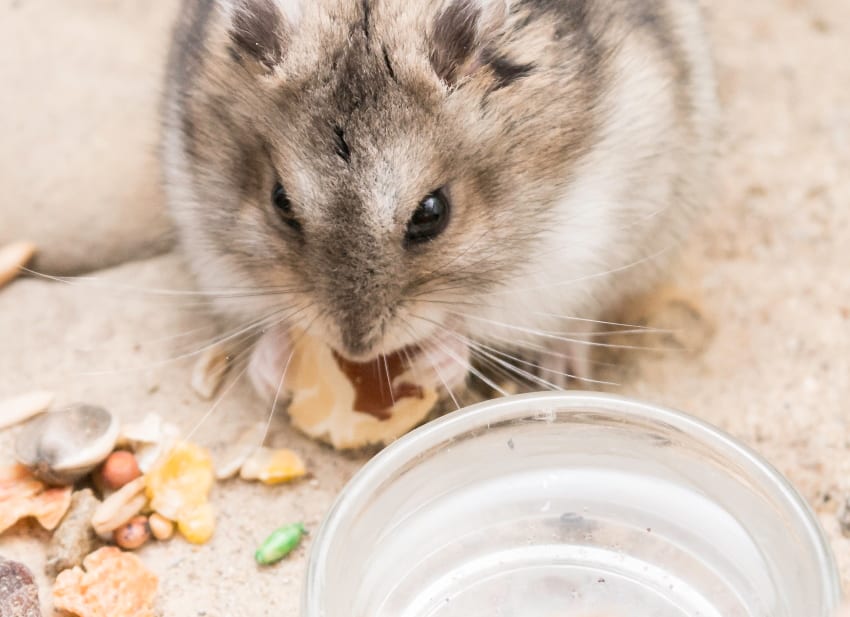
A hamster diet can be pretty complex to figure out when you’re just starting (I still get overwhelmed even after researching about it for so long!).
The thing with hamsters is that there isn’t just one hamster – there are several different species we keep as pets, and each one comes with slightly different dietary requirements. So instead of feeding your pet a “hamster, raccoon & *insert animal*” food from the pet store, hamsters do best when fed a species-specific diet.
There are two main ways to feed your hamsters:
- Food mixes
- Pellets or lab blocks
While pellets are made to prevent selective feeding, they are an extremely boring way to feed your pet. To hamsters in captivity, foraging for food and experiencing different tastes is what keeps them happy, occupied, and mentally stimulated. If they had to eat the same thing day after day, served in a bowl, there would be nothing else to do in a day. Your hamster would soon get bored and stressed. That’s why it’s important to feed your hamster food mix in addition to pellets.
Food Mixes
What kind of food mix is good for your pet? That depends on your hamster’s species. Unfortunately, pet stores don’t usually sell species-specific mixes, so you’ll have to dig a bit more to find a good product.
I like to refer to The Hamingway foodmix app to see which food mixes are high-quality.
Some good sources that sell species-specific hamster food are:
- Robin’s Gourmet Food (USA & Canada):
- Their fortified diet contains pellets to ensure a stable source of micronutrients and can be used as a complete diet (you just need to add fresh vegs).
- Their pellet-free food can be mixed with high-quality commercial pellets to ensure your pet gets the micronutrients they need.
- Their basic food mix doesn’t contain animal protein or pellets, so it should be supplemented with insects and high-quality commercial pellets.
- RodiPet (Europe)
- Getzoo (Europe)
- Mixerama (Europe)
- FutterParadies (Europe)
- Futterkraemerei (Europe)
Keep in mind that some of these food mixes are not a complete diet because they don’t contain animal protein which should be given extra.
Animal Protein
Hamsters are omnivores, so they need animal protein to get all the nutrients their body requires. The most natural way for them to get animal protein is in the form of insects such as mealworms, crickets, and grasshoppers which they would eat in the wild. If you run out of those, you can give your pet some cooked chicken (unseasoned) or eggs, but this should not be the main source of animal protein for your pet – they need insects.
Fresh Food: Vegetables, Plants
In addition to the food mix and animal protein, your pet should also get small bits of vegetables and plants once or twice a week. Here’s a list of vegetables that are safe for hamsters.
Syrian hamsters can have a small piece of fruit here and there, but dwarf species are better off without it as they are highly prone to diabetes. Dwarf’s natural diet doesn’t include fruits, and their bodies haven’t evolved the ability to tolerate sugary foods. This also goes for sugary vegetables such as carrots.
Key Components of a Healthy Hamster Diet
To sum it all up, a healthy diet for your hamster includes the following:
- a high-quality species-specific food mix
- fresh food, including vegetables and herbs 1-2 times a week
- animal protein (if it’s not already included in the food mix)
- high-quality pellets to use together with your food mix
It’s recommended to add high-quality pellets to your hamster’s diet (for example, mix it 50:50 with a food mix) if you’re not confident in the food mix you’re using and want to ensure your pet is not missing anything nutritionally. Science Selective Hamster Food is a good choice with suitable protein, fat, and fiber percentages while not containing artificial colors or added sugar.
What to do if you don’t have access to species-specific hamster food?
If you don’t have access to a species-specific hamster food mix in your area, many hamster owners use Higgins Sunburst Gourmet Blend in combination with high-quality pellet food such as Mazuri Rat & Mouse Diet.
Higgins Sunburst Gourmet Blend is known for its great variety, containing 19 different ingredients. However, the protein levels are on the lower end, so this mix should be supplemented with additional protein sources. If you combine it with Mazuri Rat & Mouse Diet which has a high protein content (23%), it forms a balanced diet.
Chew Toys
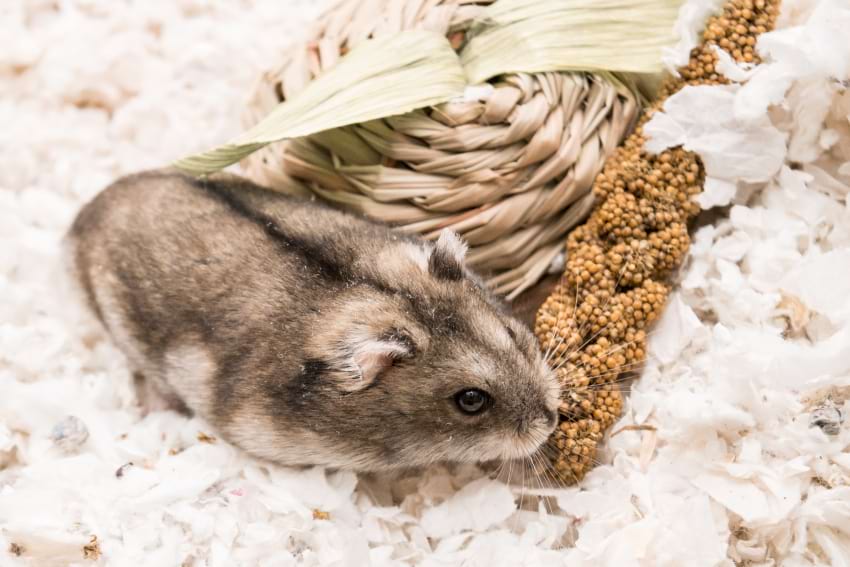
Like all rodents, hamsters have teeth that never stop growing. So they need something to chew on to help them wear down the teeth and prevent overgrowth.
Some good chewable options are:
- Wooden chew sticks
- Untreated wooden blocks
- Whimzees (since these are edible, they should only be given occasionally)
- Dandelion and nettle roots
- Willow balls
- Nuts such as walnuts and hazelnuts
- Toilet paper roll
- Hamster-safe tree branches and twigs
- Cardboard
Cage Accessories and Enrichment
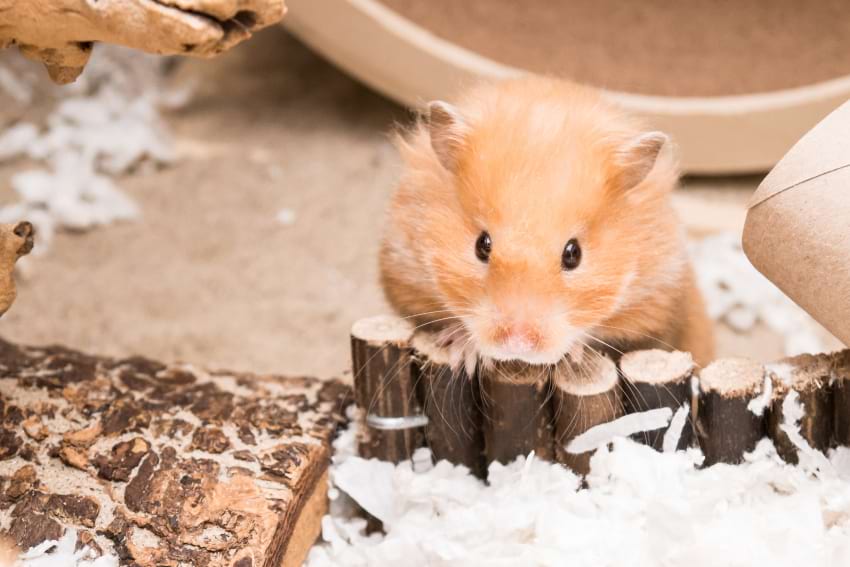
Hamsters need fun and enriching cage accessories to keep them occupied and mentally stimulated. Aside from a wheel, many other items make a great addition to the cage and are loved by hamsters.
Providing various textures to walk on and interact with makes an excellent stimulation for your pet. In addition to deep bedding and a sand bath, you can add more digging areas that contain safe textures such as:
- Coconut fiber
- Hemp
- Granule paper bedding
- Shredded cardboard
- Coco husk
- Sphagnum moss
These additional digging areas don’t have to be deep as you already have your main substrate for burrowing – and the beddings used in digging areas are usually not good at holding burrows.
Some enrichment items for the cage are:
- Cork logs
- Hideouts
- Wooden bridges
- Wooden ladders
- Tunnels
- Platforms
- Hamster-safe herbs, flowers, and plants
- A rock to wear down hamster’s nails – you can either buy a rock or use one from outside (in that case, give it a good scrub with hot water and soap)
A Playpen
Some hamsters can’t wait to spend time outside of the cage, while others don’t particularly like it and prefer relaxing in their cage where they feel safe. Nevertheless, hamsters should be allowed to spend some time outside their cage to exercise in a larger area.
Start slowly when introducing your hamster to an out-of-cage space so they don’t get overwhelmed. Your hamster will probably start enjoying it when they form a bond with you and get to know the surroundings.
When your hamster is out of the cage, supervise them at all times and keep all other pets away. You don’t necessarily need to use a playpen for out-of-cage time. You can let your hamster run free in a small hamster-proofed room or a fenced-off area.
Add hideouts to the play area so your pet can hide if they feel scared, and give them something to do by providing toys and scattering food or treats.
A Carrier or a Small Travel Cage
Sooner or later, you’ll need to transport your pet to a vet or somewhere else, so it’s important to have a travel cage ready for those situations. A simple carrier will do just fine, or use a “starter cage” – these cages are far too small for housing a hamster but can be used as a travel cage.
Exotic Vet & Emergency Savings
Hamsters need an exotic vet, and it can be hard to find one who treats hamsters. That’s why it’s important to call around and find a vet for your pet even before you adopt them. You never know how soon they might need vet treatment.
A vet fund for your pet will make all the difference, as the treatment can be surprisingly expensive. By saving up in advance, you’ll be able to afford a vet when necessary, no matter the costs.
Final Thoughts on Hamster Supplies
This wraps up our list of essential hamster supplies. Hopefully, this has given you an idea of everything you need to keep your hamster happy and healthy.
As you might have noticed, getting a pet hamster is not cheap if you want to care for them properly! All these expenses easily add up, so before committing to a new pet, make sure you can afford all the necessary supplies and vet treatment.
The good thing is that after the initial purchase of all hamster supplies, you only need to buy food, toys, and bedding which is not that expensive since hamsters don’t eat a lot, and their bedding doesn’t need to be changed very often.
Is there anything else you’d add to our hamster supplies list?
Let us know in the comments!



